In the middle of a municipal park in East Vancouver, on unceded and shared Musqueam, Squamish, and Tsleil-Waututh territory, a wet buffalo hide was stretched on a wooden frame. The hide had been prepared the day before for a group of people to participate in brain tanning it over the weekend of Saturday July 26th and Sunday 27th, 2025. An eagle nest, high up in the cottonwood trees watched over us as we gathered amidst community gardens, a baseball diamond and a skate park.
The bison hide tanning was hosted by Young Agrarians (YA) in partnership with Ancestral FoodWays Collective Society (Ancestral FoodWays). What emerged from the weekend was something greater than we expected. It became a grounding and connective experience that brought together knowledge sharing, hard work, connection to culture and connection to each other.
Below follows a re-cap of the event, day by day, and reflections on the felt impact and experience of this gathering.
Day 1: Fleshing the wet hide
The first day, Saturday, consisted of fleshing the hide, a labour intensive process where all the remaining flesh attached to the hide after butchering is scraped away. Folks who came out to offer their time and labor took turns fleshing the hide in groups of threes, fours and even sixes at times. Fleshing a bison hide can take one person 6-8 hours or more of constant hard work, so to have so many hands allowed everyone to take turns between fleshing, resting and socializing.
We used a variety of tools for the fleshing process and everyone got to try their hand and the different tool types. There was a combination of traditional tanning tools such as leg bone scrapers and flint knapped stone scrapers and metal tools of various styles and shapes.
While the wet hide was being fleshed (on left, photo below) a second hide that had previously been de-haired and dried was being dry scraped to get it ready to use as rawhide for making drums (on right, photo below).
While the wet hide was flexible, it took a lot of muscle and the full day until 5pm to remove all of the flesh. The dried rawhide needed more of a gentle scraping action to reach a desired thinness and smooth texture. It was then taken off the frame and rolled to store for future drum making.
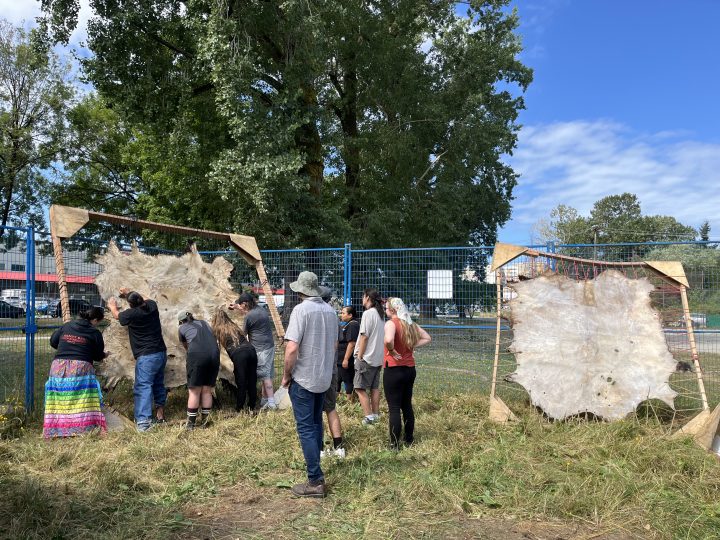
The group at work, processing bison hides together
This gathering was co-hosted by Ancestral FoodWays Collective Society, a non-profit organization that provides access to cultural foods for Indigenous folks in Vancouver. In 2023 Ancestral FoodWays did a nose-to-tail bison harvest of bison at an abattoir near tk’emlups. The meat, organs, bones and hides were collected to be used for community meals and cultural programming. The bison meat was cooked and shared at community feasts as well as shared with community members in Vancouver’s Downtown Eastside.
The hide that was fleshed over the weekend was one of six from that harvest. Two had been tanned the previous year and used as hair-on blankets for seating in ceremony, and we spent time sitting with them as we worked over the weekend. One had been prepared as a rawhide (pictured above). We were able to finish this one together over the weekend, along with the one that we fleshed, brain tanned and smoked this July. The last two were being moved onto the next stages of our shared work: one we de-haired and stretched to become a second raw hide; and the final hide was gifted to a partner community organization to tan and use for cultural teaching.
This bison hide project took place over a four year time period. From Ancestral FoodWays’ relationship building with the bison farm and abattoir, collecting the hides and organs, to collaboratively tanning the last hide together this past month. The journey reaches back much further to knowledge carried forward by Indigenous communities and knowledge keepers since time immemorial. The journey also reaches forward in time, in an assertion of Indigenous rights, culture and knowledge. The buffalo endured a shared experience of genocide to that of Indigenous peoples on turtle island. Seeing the resurgence of the buffalo in this small but impactful way was a healing experience.
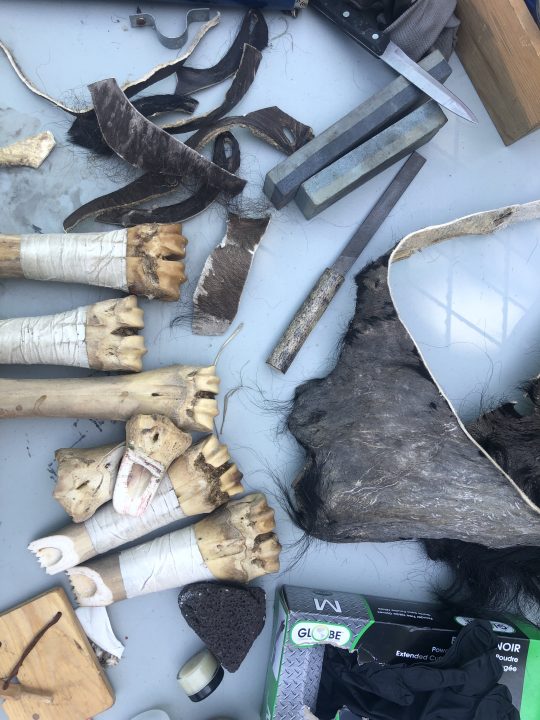
A selection of tools including bone fleshers
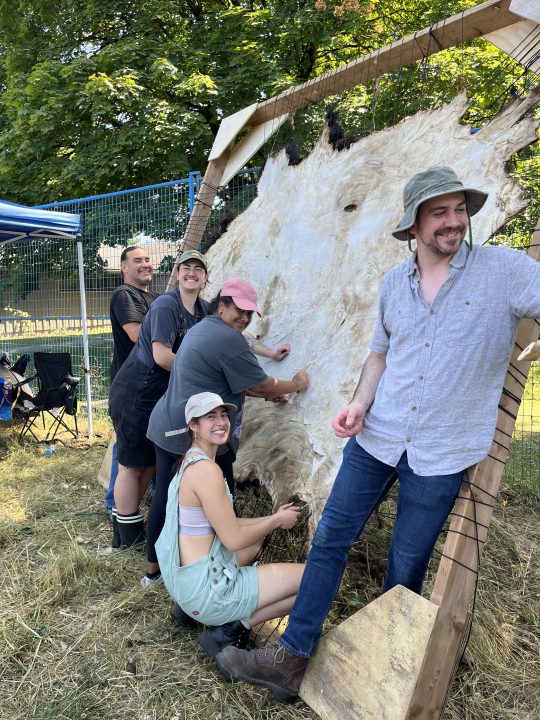
Smiles across the drying bison hide
On Saturday morning people began arriving even earlier than the posted start time, eager to learn more about hide tanning and share in on-the-land cultural activities. We welcomed their eager hearts and started with an opening circle with about 30 of us present. We shared a bit about ourselves, our names, pronouns and ancestries, and answered the prompt: “Please share a story about your relationship to bison or what buffalo/bison mean to you.” Folks from varying walks of life shared their appreciation for the bison, what bison mean culturally and spiritually to them or ecologically for the environment.
It was also exciting to hear that most people there had no experience with hide tanning and were grateful for an offering like this in an urban center. A smudge was then led by Chance, one of the Ancestral Food Ways knowledge sharers, to open the weekend in a good way.
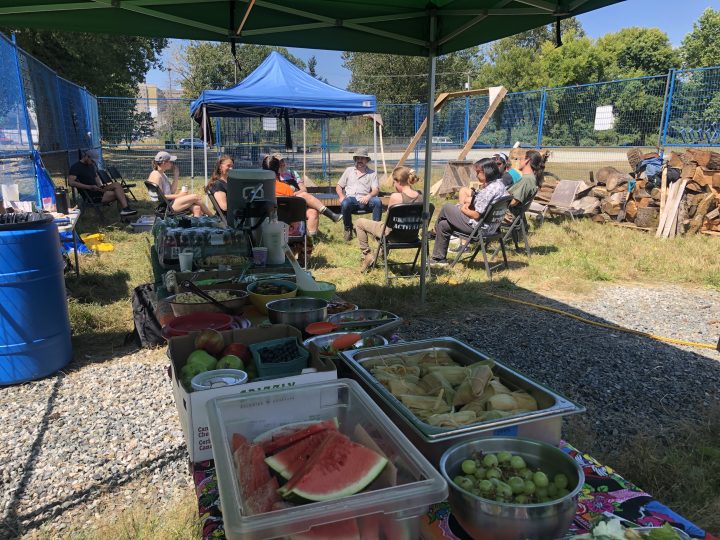
A bountiful potluck
Folks were so gracious with their potluck offerings. We shared a feast that included blue corn, bison, berry and chicken tamales, fry bread, bannock, chicken adobo, loads of fresh fruits, and abundant salads to name a few of the delicious items. Not only was the spread of foods tasty, it fuelled us all through the hard work of hide tanning. Ancestral FoodWays prepared the delicious tamales and provided everyone with ice cold horchata which kept us hydrated and cool in the heat.
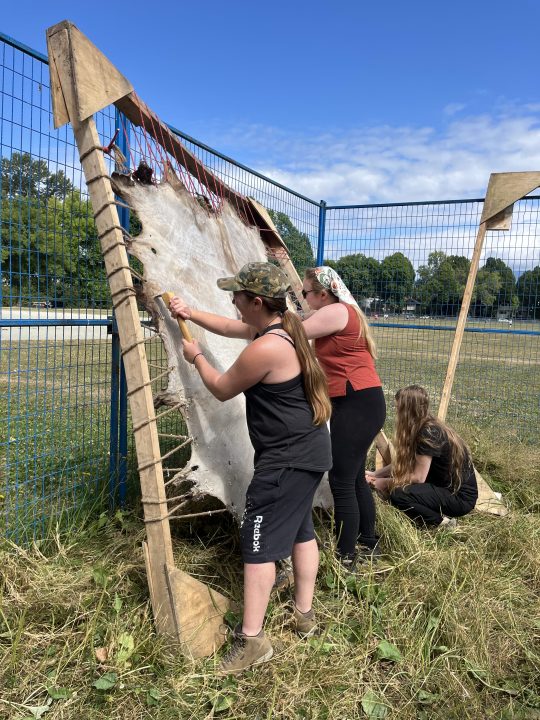
Scraping the rawhide
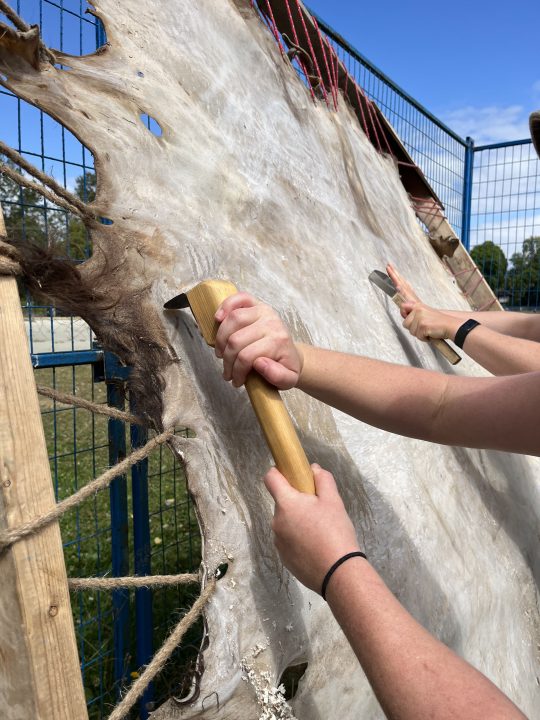
Scrapers closeup
Day 2: Braining and
Softening the Hide
The same participants from day one met for a second day at Strathcona park, as well as a few new faces. In preparation for the event we had removed nine pig brains from pig heads we had collected from an abattoir in Chilliwack. This was used in our brain tanning solution: a mixture of pork fat, brains and warm water.
We started by filling any holes in the stretched hide and poured the tanning solution all over the hide (photo below). Though rubber aprons and gloves were provided, as this can be messy work, folks were undeterred. Everyone got right into the softening phase, working the brains in with their hands and later with various tools. Some even getting onto the hide allowing their body weight to stretch the hide. This is an essential step in brain tanning, the stretching helps to open and separate the fibers in the skin which gives the hide its soft texture and suppleness.
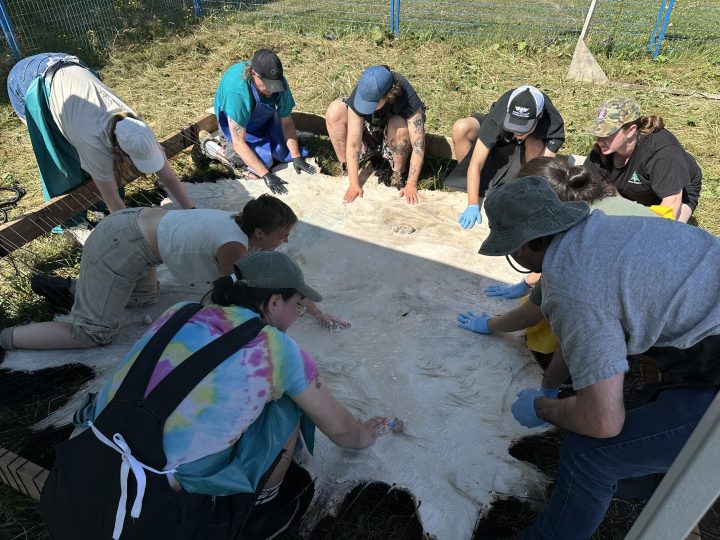
Massaging in the brain solution
Once the hide had absorbed all of the liquid but was still wet to the touch, we lifted the hide upright to continue the softening process. Folks were enthusiastic about throwing their weight into the hide helping it to stretch and soften. Considering this is a laborious process, especially in the heat of the July sun, it was incredible to have so many helping hands.
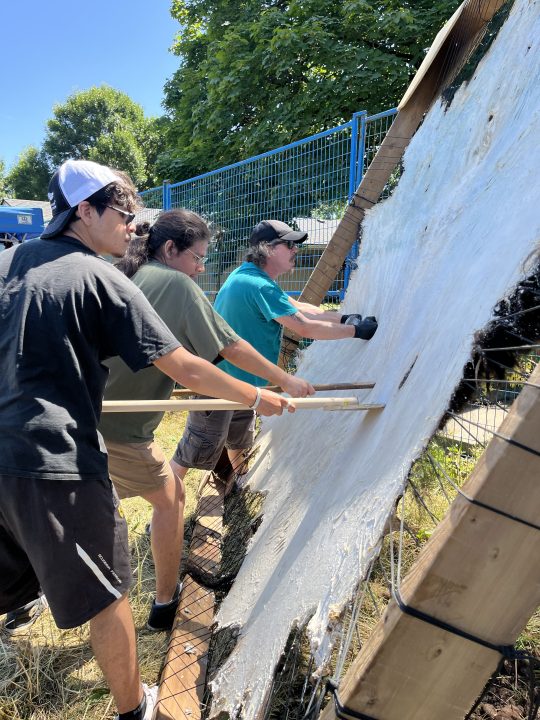
A family working together
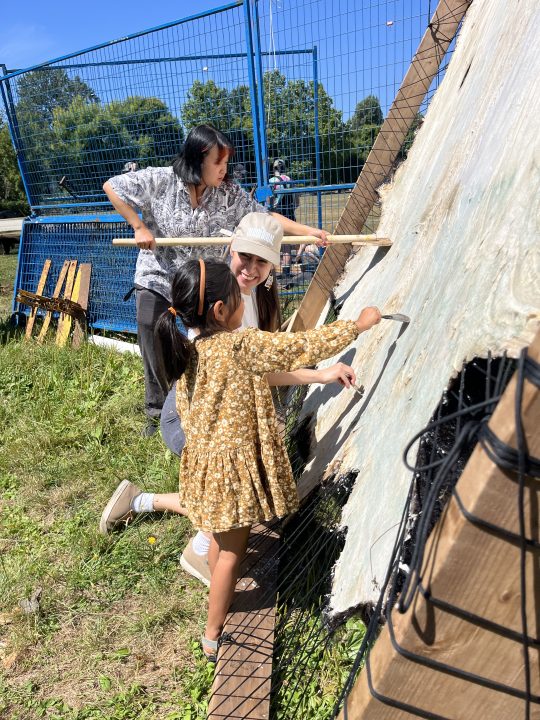
Intergenerational learning
Everyone’s enthusiasm and gratitude was apparent. Folks were just as eager to participate and learn more on the second day and by the end of the day when everything was getting packed up there were still people giving it their all, continuing to soften the hide.
The bison hide tanning gathering turned out to be such a beautiful community effort. Hide tanning takes many hours of hard work, and many hands made the work seem so much more joyful. The sense of community and assertion of Indigenous sovereignty that everyone contributed to also really strengthen this on the land experience in the center of a vast city. On the following Wednesday the hide was smoked to complete the tanning process. The bison hide will be used in ceremony and cultural programming by Ancestral FoodWays.
Thank you to Ingrid Figuaroa, Daniel Mendoza, Claudia Paez and Chance at Ancestral FoodWays Collective Society for co-hosting this enriching community event!
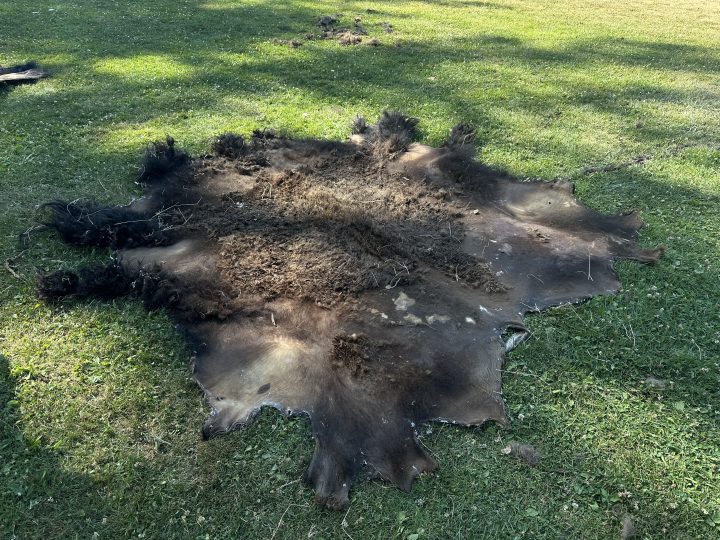
Tanned bison hide
Reflection: Why is this Important Work in Vancouver’s Downtown Eastside
The Downtown Eastside of Vancouver has the largest demographic of Indigenous people in the city at 31%; despite Indigenous people only making up 2.3% of Metro Vancouver’s population. The Downtown Eastside is a place where the ongoing criminalization of poverty impacts many, yet rising up from this is a strong sense of solidarity and a desire to create community and lift each other up. Many of the folks that were part of the hide tanning gathering expressed that on-the-land cultural opportunities were rare in such an urban place, even in a city with a strong Indigenous presence.
Tanning a buffalo hide on the land in the middle of a city park was a reimagining of what these spaces can be. For many Indigenous folks these parks represent the displacement of Indigenous people and erasure of cultural practices to create regulated, manicured and soulless green spaces. This shared and felt sense of displacement is mirrored by the experiences of the buffalo.
So many who attended the event expressed how strong the feeling of community was in this shared experience. Even greater than that: it felt like a strong assertion of Indigenous presences on the land through one small but intentional act towards Indigenous sovereignty, food sovereignty and cultural resurgence.
Hide tanning traditionally would have been a time of strengthening relationships through countless hours working together. To see this same effect taking place before our eyes was transformative, especially in an era when connection and community can be so hard to find in urban places. It is difficult to put into words this feeling of palpable connection that we felt and had reflected back to us in feedback. The gathering was even more enriching than we had anticipated. It became something greater, an assertion of Indigenous presence and practice on the land and a blossoming of community connection where it was most needed.
Indigenous folks were prioritized as participants, through Ancestral FoodWays and YA’s networks. Registration for Indigenous participants was free. Non-Indigenous folks who attended purchased tickets. All proceeds went to Ancestral FoodWays Collective Society.
Resources:
Indigenous Led Buffalo Rematriation
Reporting in Indigenous Communities: Vancouver’s Downtown Eastside
Reach out to connect with YA’s Indigenous Food Sovereignty program:
YA looks forward to the ongoing conversations held in and beyond this event. The YA Indigenous Food Sovereignty program is emergent and relationship based, and welcomes connection and conversation.
Email: maria@youngagrarians.org
Check out Ancestral FoodWays Collective Society online:
Website: ancestralfoodways.com
Instagram: @ancestralfoodwayssociety


 Filter by Popular Categories
Filter by Popular Categories